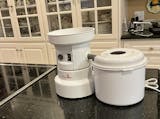Have you ever considered making your own flour at home? It's a truly rewarding process and whether baking, making bread flour or an all purpose flour, nothing beats creating your own flour. Fresh flour provides a fresh ingredient for your bread baking, or whatever you choose to use it for, and can be so much better than store bought flour.
Not only does homemade flour taste better but it's also a great source of Vitamin E. Because you are using flour as soon as it has been milled, you are using it at the peak of its nutritional value, much like when you use freshly picked fruit.
What are the benefits of homemade flour?
Nutritious and cost effective
Not only is freshly ground flour more nutritious, it also has a number of other benefits too. Perhaps one of the main additional benefits is that buying wheat berries is much more cost effective than buying store bought flour, especially when bought in bulk. In the long term, milling flour could save money on a significant scale.
A wider choice
Another great benefit of making your own flour is that you can choose from a variety of different grains. You could make whole wheat flour or even use gluten free grains. It also gives you the chance to experiment in mixing different types of flour to create different textures, for instance mixing a finer flour with a more coarse flour. You won't get the same variety of choice in grocery stores.
A better finished product
Freshly home milled flour can create a much better flavor than store bought flours. Because the flour has not been over processed and is as fresh as it can be, it can bring a whole new level of flavor to your baked goods. Additionally, the healthy fats within freshly ground flour (particularly whole grain flour) have not become bitter with age and so create a much sweeter tasting bread or baked good.
A longer shelf life
Generally, whole wheat flour bought from a store will last around 6 months and white flour can last up to 1 year. Wheat berry can last indefinitely as long as it is stored properly until you need them, preferably in an airtight container and in a cool and dry place.
As a cost saving exercise, this is the perfect solution, as you simply mill the flour that you need, when you need it.
What is homemade flour made from?
Homemade flour is made from wheat berries. There are actually some distinct types of wheat berries to choose from, depending on what finished product you hope to achieve.

What types of berries should I use to make homemade flour?
Generally, the choice of wheat berries comes down to hard or soft, red or white. The hard varieties of wheat berries tend to contain more protein and gluten, whereas the soft wheat berries contain more starch. Soft wheat berries are commonly used more in more delicate baked goods such as pastries, whereas hard wheat berries are more commonly found in bread.
There is no set rule for wheat berries however and it's a good idea to experiment to see which works best for you.
Next, you can choose from red wheat berries or white wheat berries. Red wheat berries are generally darker in color than white wheat berries and are used to make whole wheat flour. Red wheat berries are higher in protein and can make a heavier flour ideal for hearty bread recipes.
White wheat berries are used to make whole white wheat flour. Their lighter colour and texture lend them to a lighter bread or baked good.
Wheat berries vs quantity of flour
The quantity of flour you produce is entirely dependent on how finely you mill the wheat berries. Air also contributes to the volume of freshly milled flour. However, as a general rule, one cup of wheat berries will produce approximately 2 cups of freshly milled flour.
How to store wheat berries and freshly milled flour
Wheat berries should be stored in a cool environment, preferably in an airtight container. In order to keep a store on-hand, it's perhaps best to store a large quantity in a pantry or out-house and store small amounts in large mason jars so that they can be stored in the kitchen and accessed quickly.
Freshly milled flour can be stored in an airtight container for up to 3 months, so it's pretty long lasting! However, it does perish more quickly than store bought flour, so keep an eye on it. You can home freeze flour too if you have the capacity.
What should I use to mill my flour?
There are three main options for milling your own flour at home. These are; using a coffee grinder, using a food processor or using a grain mill machine.
A coffee grinder is OK for beginners as it works in much the same way as grinding coffee beans, however you are unlikely to get the desired consistency from your first grind and it may take several attempts to get to an acceptable fine flour texture. It's unlikely you'll get the perfect texture from a coffee grinder as it is not really designed for this purpose. You can't mill flour in vast quantities in a coffee grinder either, as it simply does not have the capacity.
A food processor is another option for freshly ground flour. Because of the robustness of wheat berries, a food processor or high speed blender could get damaged over time, as they are not really designed to grind grains.
Perhaps the best option, and to produce the best results, is to use a grain mill. Because a grain mill is specifically designed for milling flour, it will produce the best texture and has the capacity to produce more flour at one time.
Using a grain mill is perfect if you want to experiment with bread making, as you can produce different textures, flavors and use different grains.
What type of grain mills are there?
Grain mills are available to suit many needs and budgets. When home milling, there are a number of grain mills available on the market. Your choice of grain mill all depends on your purpose.
As a beginner, you may want to look atmanual mills to start with. This will give you a good idea of the quantity and texture that you can produce. Manual mills such as theWondermill Wonder Junior Deluxe Manual Grain Mill W/ Nut Butter Auger, are perfect for fast milling that is easy to clean and produces consistent results. For a machine which offers the best of both worlds, you could also try the Lehman’s Green Power Grain Mill. This mill is manually operated.
If you're looking to grind flour on a commercial basis, for instance if you are setting up a bakery, then it might be worth considering a commercial capacity mill such as the Meadows Mills 8 Inch Stone Burr Grain Mill. This mill can produce up to 50 pounds of flour per hour, and so it is ideal for a small bakery. For larger ventures, the Meadows Mills Stone Burr Grain Mill, 30 Inch is capable of producing up to 1000 pounds per hour.
For home use, the ideal solution is anelectric mill. Electric mills are suitable for a range of budgets and can be stored conveniently in your kitchen. At the lower end of the budget spectrum, theNutriMill Classic High-Speed Grain Mill offers everything needed to produce homemade flour. It's convenient, powerful and fast and enables you to make up to 2 cups of flour at a time. At the higher end of the budget spectrum is the Mockmill 200 Professional Grain Mill, which allows you to continuously mill grain for extended periods, producing 200g of flour per minute to a perfect flour consistency.
When purchasing a grain mill, it's best to consider; do you need large quantities of flour at one time and do you have the space to store a larger grain mill or would a manual mill be more suited to your needs and space? There's no point in buying a grain mill that produces huge quantities if you don't have the room to store the machine or the produce.

How to make flour at home using a grain mill - a step by step guide
The first step is to gather your chosen wheat berries in the quantities that you wish to produce and to set up your preferred milling method.
Next, pour your wheat berries into the top of the machine or grinder, bearing in mind that air adds volume to the amount of flour that you produce, so you'll have less volume of berries than the flour that you ultimately produce.
Next, dependent on which machine you use, adjust the settings to the desired consistency of your flour. The finer the setting, the more like store bought flour your end product will be.
Finally, set your speed slowly at first and then increase it as the machine starts to grind. The sound of the machine changes once all the wheat berries have been ground. You're now ready to use your flour!
Tips for baking with freshly ground flour
Homemade flour is slightly different to store bought flour and so you need to bear this in mind when using it for baking.
The key differences are:
It's more dense
Due to the quantities of bram and germ present in homemade flour, the freshly milled flour is denser than store bought flour. It can make a difference with bread baking, so be aware of the quantities you are using.
It has a different flavor
Homemade flour has a nutty flavor and is sweeter than store bought flour. It really adds a different dimension to your baking.
Higher quantities required for certain recipes
Store bought flour can settle over time but homemade flour doesn't. This means that one cup of store bought flour can be heavier than homemade flour. It's best to experiment to see if recipes need a little more of your homemade flour added to them.
What to do next
If you are excited to experiment with producing your own flour, then Extreme Wellness Supply has a number of flour mill options open to you, to suit all budgets. Once you make your own flour, you'll never go back!



















